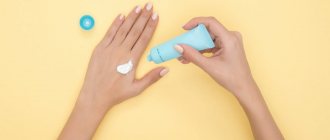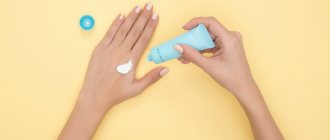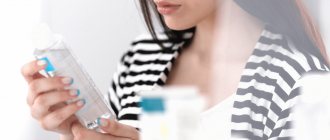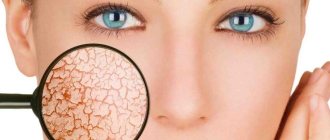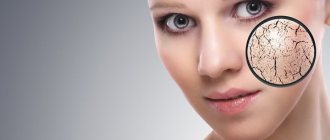First of all, let's clarify the symptoms. Peeling on the fingers or feet means dry skin, the formation of superficial blisters, and lamellar detachment of the skin.
Often, red, “tight” skin is visible under the peeling top layer. As part of self-medication, parents often resort to ointments, which gives a short-term improvement, but within 24 hours the child’s condition worsens again.
As with any symptom, we recommend making an appointment with a dermatologist rather than treating yourself. There are many diseases and ways to treat them.
Similar symptoms give:
- atopic dermatitis; - contact dermatitis; - eczema; - exfoliative keratolysis; - mycosis; - endocrine diseases; - allergic reactions; — lack of vitamins A and E; - incorrectly selected clothes; — violation of hygiene; — fungal diseases; - and many more reasons, with different tactics for their treatment.
Why do cracks appear?
The skin of the fingers protects the muscles, blood vessels, and nerve endings, which are so important for performing delicate work. It is in this part of the body that this organ is exposed to the greatest mechanical, temperature, and chemical influences. The cells of the epidermis are so organized that they are able to compensate for the influence of unfavorable factors for a long time. However, in the presence of somatic pathology, a lack of vitamins, microelements, or an imbalance of water balance, the skin ceases to recover quickly. Impaired blood supply and cell nutrition leads to the appearance of painful, difficult-to-heal cracks.
External causes of skin cracking
The reasons why the skin becomes very dry, the corners and bends of the fingers burst, may be different for men and women. Among the former, a neglectful attitude towards hands prevails, combined with harmful work in the fresh air. The latter have exposure to household chemicals, frequent and prolonged contact with water, and somatic pathologies.
All external factors that cause the skin to dry can be presented in the form of a table.
| Mechanical | Chemical | Physical |
| Rough mechanical work performed by hand, without the use of protective equipment | Long-term work in the home with constant contact with water, especially chlorinated | Chapping (cold air), walking without warm gloves |
| Short nails that don't protect your fingertips | Contact with household chemicals without wearing gloves (cleaning powders, toilet cleaners, dishwashing detergents) | Chapping of wet hands in the cold, especially in winter |
| Fine but intense finger work (sewing, dentistry and other fields) | Frequent hand washing with soap | The air is too dry |
| Treating hands with antiseptics | Excessive exposure to UV rays | |
| Using low-quality or unsuitable cosmetics | Prolonged exposure to high or low temperatures | |
| Contact with construction mixtures, glue, paint, plaster without gloves | Temperature difference | |
| Gardening work without the use of protective equipment: contact with soil, clay, ash, chemicals | Irradiation |
If the reason why your hands are cracking lies in external factors, the wounds are located on the back of the hand, do not appear in the leg area, and heal quickly.
What diseases lead to cracking of the skin?
The dominance of internal factors leads to the formation of cracks around the nails, at the tips and on the bends of the fingers. In the presence of a somatic disease, not only the hands dry out, but also the heels, elbows, legs, back, and stomach. The resulting cracks are extremely painful and take a long time to heal.
If the skin on your fingers often bursts, the causes should be sought in the following diseases:
- autoimmune pathologies
: Sjogren's disease, psoriasis, eczema; - endocrine disorders
: diabetes mellitus, hypothyroidism; - infectious diseases
: fungal infections, streptoderma; - hormonal changes
: pregnancy, menopause, taking oral contraceptives, different phases of the menstrual cycle; - allergic reactions
: atopic dermatitis, allergic eczema; - lack of vitamins and microelements
: malnutrition, gastrointestinal diseases leading to impaired digestion and absorption; - changes in water and electrolyte balance;
- natural age-related changes in the body;
- hereditary diseases: ichthyosis, keratoderma.
The appearance of cracks in a child also indicates the need for a medical examination, since in healthy children the epidermis heals quickly.
If internal factors predominate, it is better to entrust the treatment of such injuries to a doctor. The first step is to contact a therapist, who will prescribe a blood test, conduct an external examination, and write a referral to other specialists. At the next stage, the patient will visit an endocrinologist and dermatologist.
How to make an appointment with a dermatologist
You can make an appointment with a dermatologist at the pediatric department of JSC “Medicine” (academician Roitberg’s clinic) using the form on the main page of the site. It is necessary to enter feedback information in order to agree on a convenient time and date for a visit with the child.
If it is necessary to make an accurate diagnosis, the doctor can additionally refer you for examination to other specialized specialists: an allergist, an immunologist, etc. Contact reception number for questions and appointments with doctors. The clinic has a convenient location in the Central Administrative District near the Mayakovskaya metro station at the address: Moscow, 2nd Tverskoy-Yamskaya lane, building 10. Other stations are within walking distance: Belorusskaya, Chekhovskaya, Novoslobodskaya, Tverskaya " Qualified doctors with extensive experience treat young patients with care and attention.
Take care of the health of your children together with JSC “Medicine” (clinic of academician Roitberg).
What cream will help with cracked fingers?
The first remedy in the fight against skin damage is a properly selected cream. The product should eliminate dryness, nourish the skin, and protect from harmful influences. Creams are divided into two categories: pharmaceutical and cosmetic.
Medicines are an ointment with medicinal substances:
- Bepanten
- effective ointment No. 1 for rapid healing of wounds. Contains dexpanthenol, which stimulates active restoration of the epidermis. - Solcoseryl
- an ointment containing an extract from the blood of calves. Saturates cells with oxygen, stimulates metabolism. - Balm "Ambulance"
— contains plant extracts, disinfects, anesthetizes the wound, accelerates healing. - Vitamin-containing medicines
for external use: Radevit with vitamins A, E, D3, Aekol with vitamins A, E, K and carotene. - Actovegin ointment
: in composition and mechanism of action it is similar to Solcoseryl. - Balm “Rescuer”
, containing liposomal-emulsion complex No. 6. Its advantage is that it penetrates deeply into the cells and does not irritate the skin.
You can apply cosmetic hand creams several times a day. There are many inexpensive but effective products in this category: “Vitamin-Vaseline” cream, “Velor Chic”, “Velvet Handles”. You need to choose the cream whose tube says that it is intended for dry skin and performs the function of nutrition and protection.
Clinical picture and varieties
The main symptoms of onychodystrophy in children are changes in the appearance or structure of one or more nails. Metamorphoses can be present only on one limb or one finger, on the arms and/or legs, and cover several phalanges at once. The clinical manifestations of this nail pathology are varied, as are the causes that provoke their development.
Congenital dystrophies are defined by the following terms and are manifested by the following symptoms:
- platonychia - thickening of the nail;
- koilonychia - in the central zone there is a spoon-like depression;
- micronychia - a significant decrease in the length of the nail;
- anonychia - complete or partial absence of the nail plate;
- Hippocrates' fingers - the terminal phalanges on the hands are thickened, and the nails look like convex watch glasses.
Acquired dystrophies are defined by the following names and symptoms:
- onycholysis - the plate peels off from the nail bed;
- onychorrhexis - the nail splits lengthwise;
- onychoschisis - the anterior free edge is split transversely;
- onychogryphosis - a thickened nail bends like a bird's claw;
- onychauxis - the plate becomes cloudy and darkens (even to black);
- onychoatrophy - depressions, cracks, grooves appear on the nail, it becomes thinner and completely destroyed;
- scleronychia – thickens and becomes denser;
- dyschromia - color changes in spots, stripes or completely;
- hapalonychia – softening;
- trachyonychia – the nail becomes dull and rough;
- Beau-Reilly lines – multiple transverse grooves appear in the form of arcs;
- Keller's canaliform dystrophy - a longitudinal groove appears, from which strokes extend at an angle (herringbone symptom).
Onycholysis is more often detected in childhood.
In most cases, external changes during dystrophy are not accompanied by noticeable discomfort, inflammation or pain. Such symptoms of pathology are observed only in rare cases.
Masks to eliminate dry hands and heal wounds
When cracks appear on the fingers, they are treated in various ways, including traditional methods: baths, masks, oils. There are several proven recipes for hand masks that are easy to prepare at home:
- 1 boiled potato is mixed with 1 tablespoon of milk. The mixture is applied to the wounds, paying special attention to where the fingers peel the most. The mask is used as a compress: wrap your hands in cellophane for half an hour.
- Honey-sea buckthorn mask: mix sea buckthorn oil and honey in a ratio of 3:1. The mixture is applied to the damaged areas for half an hour, after which it is washed off, then lubricated with medicinal ointment.
- Oatmeal mask: pour boiling water over the required amount of oatmeal and wait until it swells. The mixture is carefully applied to the hands, trying to cover all areas: the space between the fingers, the skin near the nails. Fifteen minutes of exposure will be enough. After the procedure, you should lubricate your hands with any suitable cream.
You should not use herbal decoctions to remove the mask, as they have a drying property. It is better to lubricate your hands with medicinal or cosmetic cream after rinsing with warm water.
A child has cracked skin on his fingers: is this dangerous?
If the cracks are small and shallow, they are not dangerous in themselves. However, they violate one of the main functions of the skin - protective. Therefore, if an infection gets into them, an inflammatory process may develop, followed by suppuration. This means that even the smallest areas of chapped skin cannot be left unattended. It is necessary to find out the reason for their appearance and begin appropriate treatment.
In addition to the possible penetration of infection, cracks in a child’s hands are dangerous for another reason. They hurt and cause discomfort; it may be difficult for the baby to bend his fingers and touch anything. They can also interfere with a child’s social adaptation, causing him psychological discomfort when communicating with peers, at school or in kindergarten.
Sources:
- Smirnova G.I. Atopic dermatitis and skin infections in children, Russian pediatric journal, 2014
- E.N. Saverskaya, Diaper dermatitis: answers to questions from pediatricians and parents in the light of current global trends, Medical Council magazine, 2019
- I.I. Ryumina, V.V. Zubkov, Newborn skin care, Healthy Child magazine, 2017
Photos of eczema
Photo album on the disease
Baths for healing cracks
Therapeutic baths should be done before using a mask or cream. A proper bath requires the following requirements:
- it should be warm (not hot);
- herbal decoctions with calendula, chamomile, and string should be used only in the presence of microbial inflammation;
- It is best to add a few drops of any oil to the bath;
- the procedure time should be limited to 10-15 minutes;
- After the bath you need to use a medicinal cream.
Before using any traditional method, you should make sure that there are no allergic reactions to the components.
It is better to treat cracked fingers with the help of the most effective baths. These include:
- Mumiyo solution: dilute several tablets in warm water according to the instructions, use for 15 minutes.
- Bath with flax seeds: pour 1 tablespoon of seeds with a glass of boiling water, leave for half an hour. After straining, add cream with a fat content of 20-30%. The procedure time is 10-15 minutes. The bath is suitable for daily use.
- Bath with tea tree oil.
After the procedure, you should not work with your hands or come into contact with irritants. Therefore, it is better to take a bath before bed, and thoroughly lubricate the dried skin with cream.
Additional measures
As a supplement to the main treatment, it is permissible to use traditional medicine. Of course, they can be used only after determining the cause of peeling of the fingertips. This is due to certain prohibitions. For example, if you have parasites or scabies, it is unacceptable to take warm baths - this can only aggravate the general condition.
Chamomile solution, in which you need to hold your hands for several minutes, helps relieve itching, irritation and other unpleasant symptoms of peeling. A number of other herbs, for example, string or calendula, enhance the beneficial effects. No less effective is sea salt for warm baths.
Important to remember:
- It is not recommended to heat water for baths to high temperatures; approximately 38-42 degrees is sufficient;
- after the restoration procedure, it is necessary to blot the cover with a soft towel with dense pile;
- It is unacceptable to use products made of hard materials for wiping, or to thoroughly rub baby’s skin.
Even healthy, but already dry fingers or palms are recommended to be lubricated with cream for additional hydration. It is acceptable to use oil solutions or, for example, multivitamin formulations. They will not only moisturize the epidermis, but will also contribute to its proper nutrition.
Do not miss
- Do not miss
A delicate question: how to properly treat foot skin fungus in order to completely get rid of the disease
Another significant factor is hand and foot hygiene, the observance of which is fundamentally important for recovery. If fungal diseases have previously been detected, it is necessary to purchase shoes or clothing exclusively from natural materials.
It is strongly recommended to pay attention to the fact that the child must have his own towel and bed linen. To prevent relapse, you will need to wash them exclusively in hot water; you can additionally use antiseptics.
Nutrition for cracked fingers
If damage appears on the thumb in the corners of the pads near the nails, this indicates a lack of nutrients. This may be accompanied by brittle nails and hair loss. Eating the following products will help heal cracks:
- eggs;
- nuts;
- butter and vegetable oil;
- fatty dairy products;
- legumes;
- greenery;
- beef;
- vegetables;
- cereals
General and specialized vitamin and mineral complexes designed to improve the condition of skin, hair and nails should be added to the diet. These include:
- Merz special dragee;
- Lady-S Formula;
- Evalar “Beauty from within”;
- Doppelgerz Beauty Biotin;
- Solgar "Skin, hair, nails."
Complex vitamin and mineral supplements also help improve skin condition and strengthen the immune system. For men, the pharmacy sells separate drugs: Alphabet for men, Men-s formula “Active Day”, Duovit for men.
How to properly care for hands with frequent cracks
Even if there is no cracking of the fingers, special rules of hygienic care and handling of the skin should be observed. They are valid as an additional component of treatment during the presence of wounds and in their absence.
- wash your hands with warm water;
- use mild soap marked “cream soap”;
- After washing your hands, apply nourishing cream;
- minimize contact with irritants, especially hard, chlorinated water;
- use gloves when working with chemicals and soil;
- in the cold season, protect your hands with mittens and gloves.
Cracks in the fingers cause a lot of trouble: severe pain, aesthetic unattractiveness. However, with the help of ointments, masks, baths, and proper nutrition, they can be easily dealt with. If you follow the rules of hand care, your skin will crack much less often.
Experts' opinion
According to the results of clinical studies conducted by the Union of Pediatricians of Russia, it was proven that when using a complex of TM LA-KRI products, the level of skin moisture decreased by 4% in comparison, and in the group that used placebo, the level of moisture decreased by 9%.
The conducted clinical study proves the high efficiency, safety and tolerability of products for daily skin care of children with mild and moderate forms of atopic dermatitis and during remission, accompanied by a decrease in the quality of life of patients. As a result of therapy, a decrease in the activity of the inflammatory process, a decrease in dryness, itching and flaking was noted.
It has been proven that La Cree cream for dry skin:
- eliminates dryness and flaking;
- retains the skin's own moisture;
- protects skin from wind and cold.



